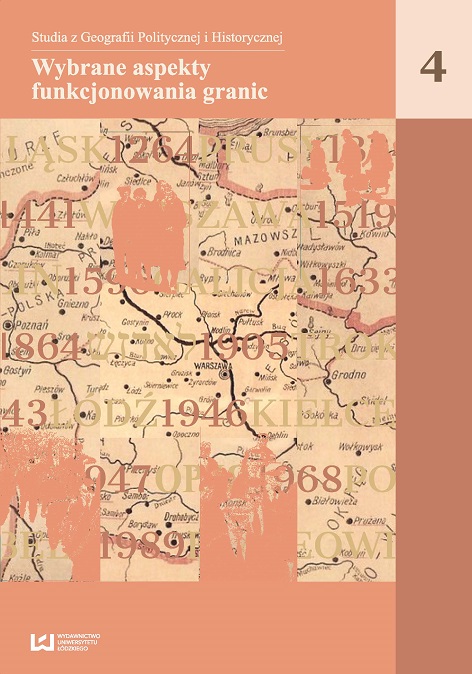Granice nazistowskich obozów koncentracyjnych i zagłady na terenie okupowanej Polski
DOI:
https://doi.org/10.18778/2300-0562.04.11Słowa kluczowe:
obozy koncentracyjne, obozy zagłady, granica, morfologiaAbstrakt
Na terytorium okupowanej Polski w okresie drugiej wojny światowej naziści założyli dwa szczególne rodzaje obozów: koncentracyjne (Konzentrationslager Auschwitz-Birkenau, KL Lublin, KL Plaszow) i zagłady (SS-Sonderkommando Kulmhof, Sonderkommando Belzec der Waffen-SS, SS-Sonderkommando Treblinka, SS-Sonderkommando Sobibor). Każdy z nich stanowił pewien zamknięty obszar, którego granice wyznaczane były w postaci konkretnych obiektów liniowych i punktowych. Morfologicznie można wyróżnić granice wewnętrzne (oddzielające strefy wewnątrzobozowe) bezpośrednie (granica właściwa) oraz zewnętrzne. Bezpośrednie granice obozów były zróżnicowane: od pojedynczego płotu aż do wielokrotnych linii drutów kolczastych z wieżami strażniczymi. Najsłabiej rozwiniętą granicę miał Kulmhof, natomiast najsilniej rozwiniętą strefę graniczną z systemem izolacji wykształcił Auschwitz-Birkenau. Głównym celem artykułu jest analiza i typologia części składowych granic nazistowskich obozów koncentracyjnych i zagłady na terenie okupowanej Polski.
Bibliografia
Bednarz W., 1946, Obóz straceń w Chełmnie nad Nerem, Warszawa.
Google Scholar
Bem M., 2011, Sobibór – niemiecki ośrodek zagłady 1942–1943, Włodawa/Sobibór.
Google Scholar
Blatt T., 2002, Z popiołów Sobiboru (skąd nie było powrotu), Włodawa.
Google Scholar
Blatt T., 2010, Ucieczka z Sobiboru, Warszawa.
Google Scholar
Chrostowski W., 2004, Extermination Camp Treblinka, London.
Google Scholar
Kiełkowski R., 1981, …zlikwidować na miejscu! Z dziejów okupacji hitlerowskiej w Krakowie, Kraków.
Google Scholar
Kola A., 2000, Hitlerowski obóz zagłady Żydów w Bełżcu w świetle źródeł archeologicznych. Badania 1997–1999, Warszawa–Waszyngton.
Google Scholar
Kopówka E., 2002, Treblinka – nigdy więcej, Treblinka.
Google Scholar
Kotarba R., 2009, Niemiecki obóz w Płaszowie 1942–1945, Warszawa–Kraków.
Google Scholar
Kuwałek R., 2005, Obóz zagłady w Bełżcu, Lublin.
Google Scholar
Lang H.-J., 2013, Kobiety z bloku 10, Warszawa: http://cyfroteka.pl/ebooki/Kobiety_z_bloku_10-ebook/p84490i99819) (dostęp: 25.11.2015).
Google Scholar
Montague P., 2012, Chełmno and the Holocaust. The history of Hitler’s First Death Camp, London.
Google Scholar
DOI: https://doi.org/10.5149/9780807869413_montague
Piper F. Świebocka T., 1993, Auschwitz – Nazistwoski Obóz Śmierci, Oświęcim-Brzezinka.
Google Scholar
Reder R., 1946, Bełżec, Kraków.
Google Scholar
Serwański E., 1964, Obóz zagłady w Chełmnie nad Nerem, Poznań.
Google Scholar
Strzelecka I., 1995, Budowa, rozbudowa oraz rozwój obozu i jego filii, [w:] Długoborski W., Piper F. (red.), Auschwitz 1940–1945, t. 1, Oświęcim-Brzezinka.
Google Scholar
Sulimierski W., 1993, Sobibór hitlerowski obóz śmierci, Chełm.
Google Scholar
Świebocka T., 1993, Auschwitz: a history in photographs, Warszawa.
Google Scholar
http://www.70.auschwitz.org/index.php?option=com_content&view=article&id=190&Itemid=176&lang=pl (dostęp: 07.07.2015).
Google Scholar
http://www.ofpc.pl/pliki/PIOTR_SETKIEWICZ.pdf (dostęp: 07.07.2015)
Google Scholar
http://www.deathcamps.org/sobibor/pic/bmap21.jpg (dostęp: 08.07.2015)
Google Scholar
http://www.dws-xip.pl/reich/zaglada/oboz1.html (dostęp: 08.07.2015)
Google Scholar
http://www.majdanek.com.pl/obozy/majdanek/strzezenie%20obozu.html (dostęp: 08.07.2015).
Google Scholar
Pobrania
Opublikowane
Jak cytować
Numer
Dział
Licencja

Utwór dostępny jest na licencji Creative Commons Uznanie autorstwa – Użycie niekomercyjne – Bez utworów zależnych 4.0 Międzynarodowe.








